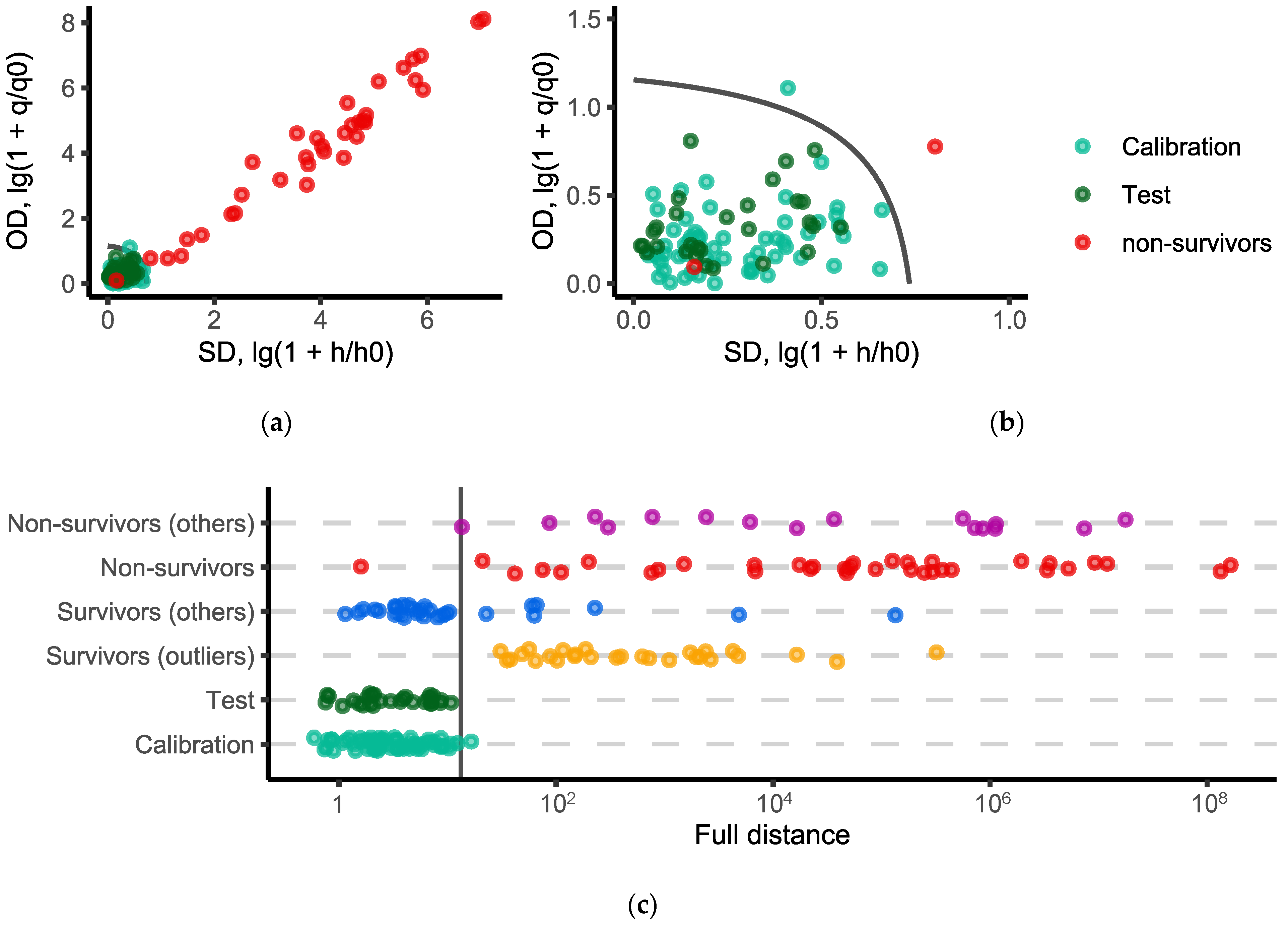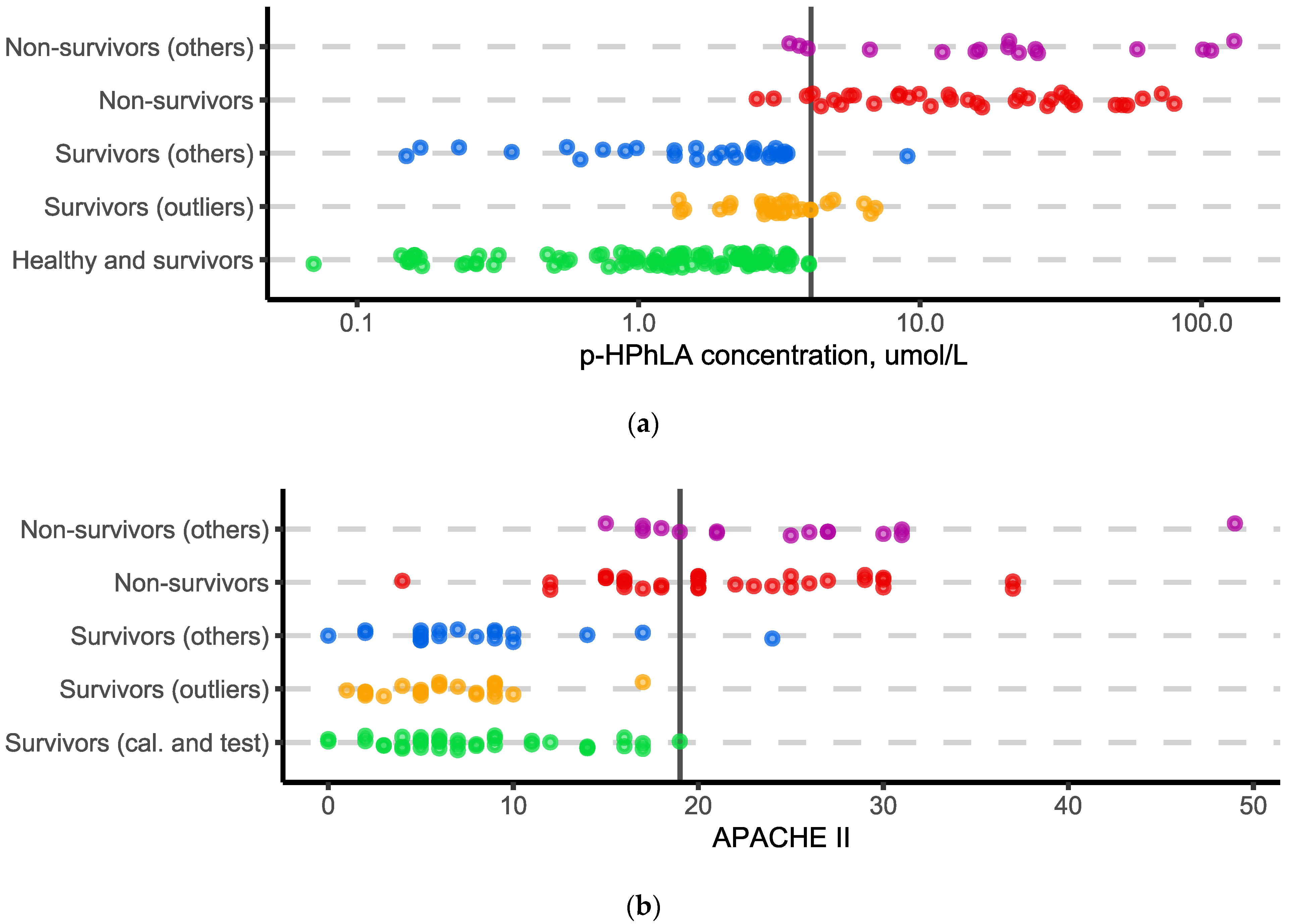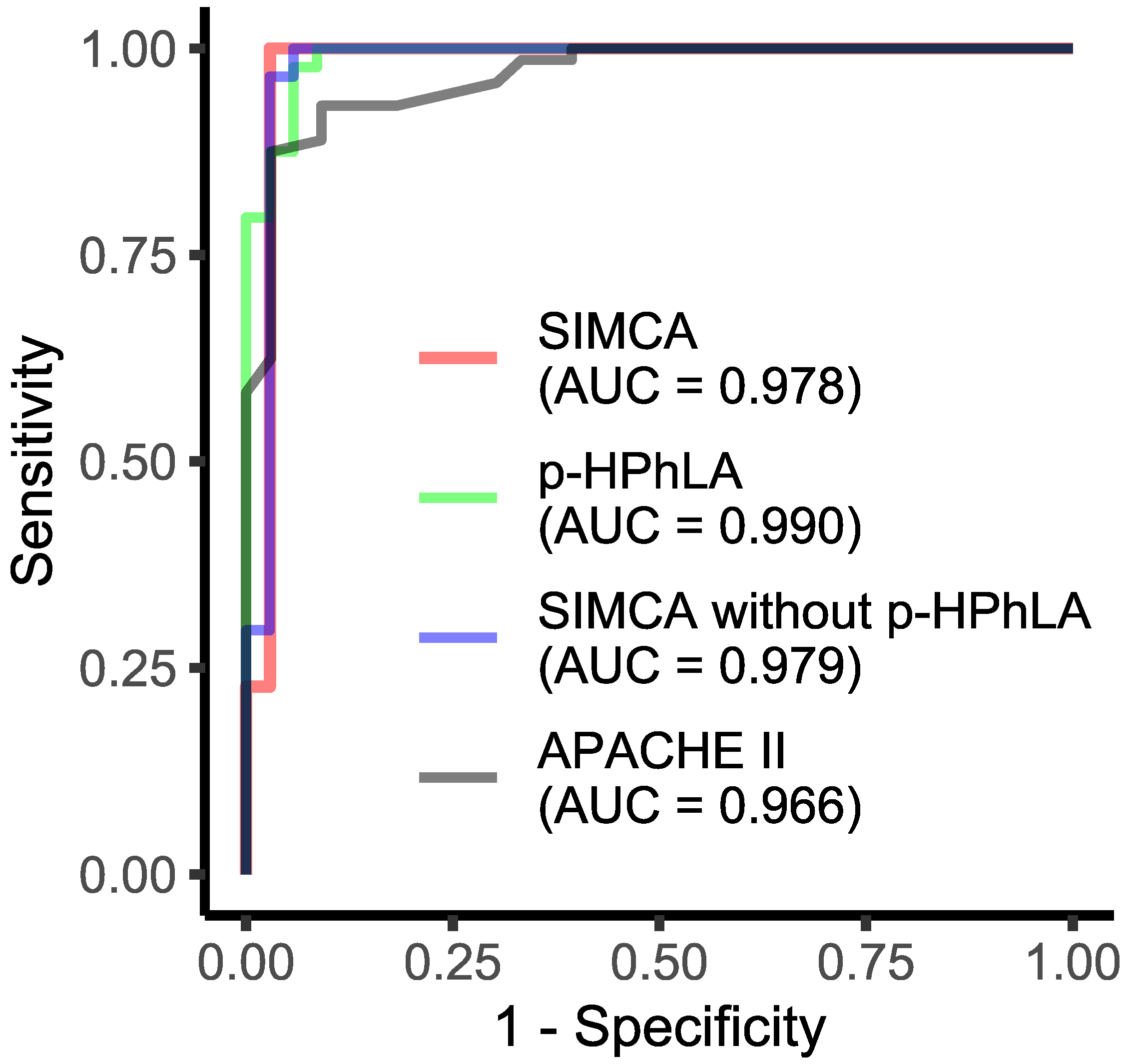Multivariate Prognostic Model for Predicting the Outcome of Critically Ill Patients Using the Aromatic Metabolites Detected by Gas Chromatography-Mass Spectrometry
Abstract
1. Introduction
2. Results
2.1. Characteristics of the Critically Ill Patients
2.2. Multivariate Classification Model Based on Eight Aromatic Metabolites
2.3. Univariate Classification Models
2.4. Multivariate Classification Model Based on Seven Aromatic Metabolites
2.5. ROC Analysis
3. Discussion
4. Materials and Methods
4.1. Reagents and Standards
4.2. Sample Preparation and GC-MS Analysis
4.3. Serum Samples
4.4. Data Processing
5. Conclusions
Supplementary Materials
Author Contributions
Funding
Institutional Review Board Statement
Informed Consent Statement
Data Availability Statement
Conflicts of Interest
Sample Availability
References
- Trongtrakul, K.; Thonusin, C.; Pothirat, C.; Chattipakorn, S.C.; Chattipakorn, N. Past Experiences for Future Applications of Metabolomics in Critically Ill Patients with Sepsis and Septic Shocks. Metabolites 2021, 12, 1. [Google Scholar] [CrossRef] [PubMed]
- Liu, Z.; Meng, Z.; Li, Y.; Zhao, J.; Wu, S.; Gou, S.; Wu, H. Prognostic accuracy of the serum lactate level, the SOFA score and the qSOFA score for mortality among adults with Sepsis. Scand. J. Trauma. Resusc. Emerg. Med. 2019, 27, 51. [Google Scholar] [CrossRef] [PubMed]
- Godinjak, A.G. Predictive value of SAPS II and APACHE II scoring systems for patient outcome in medical intensive care unit. Acta Med. Acad. 2016, 45, 89–95. [Google Scholar] [CrossRef]
- Singer, M.; Deutschman, C.S.; Seymour, C.W.; Shankar-Hari, M.; Annane, D.; Bauer, M.; Bellomo, R.; Bernard, G.R.; Chiche, J.-D.; Coopersmith, C.M.; et al. The Third International Consensus Definitions for Sepsis and Septic Shock (Sepsis-3). JAMA 2016, 315, 801. [Google Scholar] [CrossRef] [PubMed]
- Mierzchała-Pasierb, M.; Lipińska-Gediga, M. Sepsis diagnosis and monitoring–procalcitonin as standard, but what next? Anaesthesiol. Intensive Ther. 2019, 51, 299–305. [Google Scholar] [CrossRef]
- Vincent, J.-L.; Bakker, J. Blood lactate levels in sepsis: In 8 questions. Curr. Opin. Crit. Care 2021, 27, 298–302. [Google Scholar] [CrossRef]
- Beloborodova, N.V.; Olenin, A.Y.; Pautova, A.K. Metabolomic findings in sepsis as a damage of host-microbial metabolism integration. J. Crit. Care 2018, 43, 246–255. [Google Scholar] [CrossRef]
- Carry, E.; Zhao, D.; Mogno, I.; Faith, J.; Ho, L.; Villani, T.; Patel, H.; Pasinetti, G.M.; Simon, J.E.; Wu, Q. Targeted analysis of microbial-generated phenolic acid metabolites derived from grape flavanols by gas chromatography-triple quadrupole mass spectrometry. J. Pharm. Biomed. Anal. 2018, 159, 374–383. [Google Scholar] [CrossRef]
- Pautova, A.K.; Sobolev, P.D.; Revelsky, A.I. Microextraction of aromatic microbial metabolites by packed hypercrosslinked polystyrene from blood serum. J. Pharm. Biomed. Anal. 2020, 177, 112883. [Google Scholar] [CrossRef]
- Beloborodova, N.V.; Khodakova, A.S.; Bairamov, I.T.; Olenin, A.Y. Microbial origin of phenylcarboxylic acids in the human body. Biochemistry 2009, 74, 1350–1355. [Google Scholar] [CrossRef]
- Beloborodova, N.V.; Pautova, A.K.; Sergeev, A.A.; Fedotcheva, N.I. Serum Levels of Mitochondrial and Microbial Metabolites Reflect Mitochondrial Dysfunction in Different Stages of Sepsis. Metabolites 2019, 9, 196. [Google Scholar] [CrossRef] [PubMed]
- Rogers, A.J.; McGeachie, M.; Baron, R.M.; Gazourian, L.; Haspel, J.A.; Nakahira, K.; Fredenburgh, L.E.; Hunninghake, G.M.; Raby, B.A.; Matthay, M.A.; et al. Metabolomic Derangements Are Associated with Mortality in Critically Ill Adult Patients. PLoS ONE 2014, 9, e87538. [Google Scholar] [CrossRef] [PubMed]
- Beloborodova, N.V.; Sarshor, Y.N.; Osipov, A.A. Prognosis of outcome in patients with acute abdominal or pulmonary bacterial infection based on the serum level of aromatic microbial metabolites. Clin. Exp. Surgery. Petrovsk. J. 2020, 8, 96–104. [Google Scholar] [CrossRef]
- Beloborodova, N.V.; Sarshor, Y.N.; Bedova, A.Y.; Chernevskaya, E.A.; Pautova, A.K. Involvement of Aromatic Metabolites in the Pathogenesis of Septic Shock. Shock 2018, 50, 273–279. [Google Scholar] [CrossRef]
- Moroz, V.V.; Beloborodova, N.V.; Osipov, A.A.; Vlasenko, A.V.; Bedova, A.Y.; Pautova, A.K. Phenylcarboxylic Acids in The Assessment of The Severity of Patient Condition and The Efficiency of Intensive Treatment in Critical Care Medicine. Gen. Reanimatol. 2016, 12, 37–48. [Google Scholar] [CrossRef]
- Khoroshilov, S.E.; Beloborodova, N.V.; Nikulin, A.V.; Bedova, A.Y. Impact of Extracorporeal Detoxification on the Serum Levels of Microbial Aromatic Acid Metabolites in Sepsis. Gen. Reanimatol. 2015, 11, 6–14. [Google Scholar] [CrossRef][Green Version]
- Babaev, M.A.; Eremenko, A.A.; Grin, O.O.; Kostritсa, N.S.; Dymova, O.V.; Beloborodova, N.V.; Pautova, A.K.; Zakharenkova, Y.S.; Levitskya, M.V. Successful therapy of endotoxin shock and multiple organ dysfunction using sequential targeted extracorporeal treatment in a patient after combined cardiac surgery. Clin. Exp. Surgery. Petrovsk. J. 2020, 8, 105–114. [Google Scholar] [CrossRef]
- Pautova, A.K.; Meglei, A.Y.; Chernevskaya, E.A.; Alexandrova, I.A.; Beloborodova, N.V. 4-Hydroxyphenyllactic Acid in Cerebrospinal Fluid as a Possible Marker of Post-Neurosurgical Meningitis: Retrospective Study. J. Pers. Med. 2022, 12, 399. [Google Scholar] [CrossRef]
- Moviat, M.; Terpstra, A.M.; Ruitenbeek, W.; Kluijtmans, L.A.J.; Pickkers, P.; van der Hoeven, J.G. Contribution of various metabolites to the “unmeasured” anions in critically ill patients with metabolic acidosis *. Crit. Care Med. 2008, 36, 752–758. [Google Scholar] [CrossRef]
- Langley, R.J.; Tsalik, E.L.; van Velkinburgh, J.C.; Glickman, S.W.; Rice, B.J.; Wang, C.; Chen, B.; Carin, L.; Suarez, A.; Mohney, R.P.; et al. An Integrated Clinico-Metabolomic Model Improves Prediction of Death in Sepsis. Sci. Transl. Med. 2013, 5, 195ra95. [Google Scholar] [CrossRef]
- Pautova, A.K.; Bedova, A.Y.; Sarshor, Y.N.; Beloborodova, N.V. Determination of Aromatic Microbial Metabolites in Blood Serum by Gas Chromatography–Mass Spectrometry. J. Anal. Chem. 2018, 73, 160–166. [Google Scholar] [CrossRef]
- Rodionova, O.; Kucheryavskiy, S.; Pomerantsev, A. Efficient tools for principal component analysis of complex data—A tutorial. Chemom. Intell. Lab. Syst. 2021, 213, 104304. [Google Scholar] [CrossRef]
- Pomerantsev, A.L. Acceptance areas for multivariate classification derived by projection methods. J. Chemom. 2008, 22, 601–609. [Google Scholar] [CrossRef]
- Habibzadeh, F.; Habibzadeh, P.; Yadollahie, M. On determining the most appropriate test cut-off value: The case of tests with continuous results. Biochem. Medica 2016, 26, 297–307. [Google Scholar] [CrossRef] [PubMed]
- Mandrekar, J.N. Receiver Operating Characteristic Curve in Diagnostic Test Assessment. J. Thorac. Oncol. 2010, 5, 1315–1316. [Google Scholar] [CrossRef]
- Knaus, W.A.; Draper, E.A.; Wagner, D.P.; Zimmerman, J.E. APACHE II: A severity of disease classification system. Crit Care Med 1985, 13, 818–829. [Google Scholar] [CrossRef]
- APACHE II Score-MDCalc. Available online: https://www.mdcalc.com/apache-ii-score#evidence (accessed on 12 May 2022).
- Wickham, H. ggplot2; Use R! Springer International Publishing: Cham, Switzerland, 2016; ISBN 978-3-319-24275-0. [Google Scholar]
- Kucheryavskiy, S. mdatools–R package for chemometrics. Chemom. Intell. Lab. Syst. 2020, 198, 103937. [Google Scholar] [CrossRef]
- Robin, X.; Turck, N.; Hainard, A.; Tiberti, N.; Lisacek, F.; Sanchez, J.-C.; Müller, M. pROC: An open-source package for R and S+ to analyze and compare ROC curves. BMC Bioinform. 2011, 12, 77. [Google Scholar] [CrossRef]
- Snee, R.D. Validation of Regression Models: Methods and Examples. Technometrics 1977, 19, 415–428. [Google Scholar] [CrossRef]
- Eddelbuettel, D. Seamless R and C++ Integration with Rcpp; Springer: New York, NY, USA, 2013; ISBN 978-1-4614-6867-7. [Google Scholar]
- Pomerantsev, A.L.; Rodionova, O.Y. Concept and role of extreme objects in PCA/SIMCA. J. Chemom. 2014, 28, 429–438. [Google Scholar] [CrossRef]
- Kucheryavskiy, S.; Zhilin, S.; Rodionova, O.; Pomerantsev, A. Procrustes Cross-Validation—A Bridge between Cross-Validation and Independent Validation Sets. Anal. Chem. 2020, 92, 11842–11850. [Google Scholar] [CrossRef] [PubMed]




| Amino Acid | Metabolites, Acids | ||||
|---|---|---|---|---|---|
| Phenylalanine |  |  |  | ||
| Benzoic | Phenylpropionic | Phenyllactic | |||
| Tyrosine |  |  |  |  |  |
| p-Hydroxy-benzoic | p-Hydroxyphenylpropionic | p-Hydroxyphenyllactic (p-HPhLA) | p-Hydroxyphenylacetic | Homovanillic | |
| Parameters | Normal Values | Patients | 2-Tailed p | |
|---|---|---|---|---|
| Survivors (n = 44) | Non-Survivors (n = 35) | |||
| APACHE II, points | 0 | 7 (5–11) n = 43 | 20 (16–26) n = 33 | <0.0001 |
| SOFA, points | 0 | 2 (1–5) n = 43 | 10 (8–13) n = 33 | <0.0001 |
| Glasgow Coma Scale, points | 15 | 15 (13–15) n = 44 | 15 (13–15) n = 33 | 0.578 |
| Oxygenation PaO2/FiO2, mmHg | ≥400 | 305 (267–385) n = 31 | 282 (152–361) n = 31 | 0.141 |
| Platelets, ×103/μL | ≥150 | 241 (175–313) n = 44 | 166 (89–208) n = 33 | 0.0052 |
| Bilirubin, μmol/L | <20 | 12.5 (8.4–14.9) n = 42 | 19.0 (13.1–31.4) n = 28 | 0.0082 |
| Creatinine, μmol/L | <110 | 80 (67–113) n = 43 | 191 (151–263) n = 31 | <0.0001 |
| Vasopressors, % | No | 13.6% n = 44 | 91.4% n = 35 | Not available |
| Aromatic Acid, μmol/L | LOD/ LOQ Values * | Healthy Volunteers (n = 52) | Patients | 2-Tailed p | |
|---|---|---|---|---|---|
| Survivors (n = 44) | Non-Survivors (n = 35) | ||||
| Benzoic | **/0.7 | 1.3 (0.8–1.8) n (c > LOD) = 52 n (c > LOQ) = 44 | 1.9 (1.2–2.7) n (c > LOD) = 44 n (c > LOQ) = 40 | 2.5 (1.5–5.1) n (c > LOD) = 35 n (c > LOQ) = 31 | 0.0002 |
| Phenylpropionic | 0.01/ 0.59 | <LOQ (<LOD–0.73) n (c > LOD) = 37 n (c > LOQ) = 19 | <LOD (<LOD–<LOQ) n (c > LOD) = 19 n (c > LOQ) = 2 | <LOD (<LOD–<LOQ) n (c > LOD) = 16 n (c > LOQ) = 2 | 0.0001 |
| Phenyllactic | 0.4/ 0.5 | 0.6 (<LOD–0.8) n (c > LOD) = 34 n (c > LOQ) = 29 | 1.1 (<LOD–1.7) n (c > LOD) = 32 n (c > LOQ) = 32 | 4.0 (2.5–7.0) n (c > LOD) = 35 n (c > LOQ) = 35 | <0.0001 |
| p-Hydroxybenzoic | 0.2/ 0.6 | <LOD (<LOD–<LOD) n (c > LOD) = 0 n (c > LOQ) = 0 | <LOD (<LOD–<LOD) n (c > LOD) = 4 n (c > LOQ) = 2 | <LOQ (<LOD–1.9) n (c > LOD) = 20 n (c > LOQ) = 16 | <0.0001 |
| Homovanillic | 0.1/ 0.5 | <LOD (<LOD–<LOD) n (c > LOD) = 1 n (c > LOQ) = 0 | <LOD (<LOD–<LOD) n (c > LOD) = 9 n (c > LOQ) = 6 | 1.7 (<LOQ–6.3) n (c > LOD) = 26 n (c > LOQ) = 21 | <0.0001 |
| p-Hydroxyphenylacetic | 0.1/ 0.6 | <LOQ (<LOD–<LOQ) n (c > LOD) = 28 n (c > LOQ) = 2 | <LOQ (<LOD–1.9) n (c > LOD) = 32 n (c > LOQ) = 21 | 9.6 (2.8–18.5) n (c > LOD) = 33 n (c > LOQ) = 29 | <0.0001 |
| p-Hydroxyphenylpropionic | 0.1/ 0.5 | <LOD (<LOD–<LOD) n (c > LOD) = 0 n (c > LOQ) = 0 | <LOD (<LOD–<LOD) n (c > LOD) = 2 n (c > LOQ) = 1 | <LOD (<LOD–<LOQ) n (c > LOD) = 9 n (c > LOQ) = 5 | 0.0002 |
| p-HPhLA | **/0.5 | 2.1 (1.6–2.6) n (c > LOD) = 52 n (c > LOQ) = 51 | 2.9 (2.2–3.4) n (c > LOD) = 43 n (c > LOQ) = 43 | 14.8 (6.5–32.6) n (c > LOD) = 35 n (c > LOQ) = 35 | <0.0001 |
Publisher’s Note: MDPI stays neutral with regard to jurisdictional claims in published maps and institutional affiliations. |
© 2022 by the authors. Licensee MDPI, Basel, Switzerland. This article is an open access article distributed under the terms and conditions of the Creative Commons Attribution (CC BY) license (https://creativecommons.org/licenses/by/4.0/).
Share and Cite
Pautova, A.K.; Samokhin, A.S.; Beloborodova, N.V.; Revelsky, A.I. Multivariate Prognostic Model for Predicting the Outcome of Critically Ill Patients Using the Aromatic Metabolites Detected by Gas Chromatography-Mass Spectrometry. Molecules 2022, 27, 4784. https://doi.org/10.3390/molecules27154784
Pautova AK, Samokhin AS, Beloborodova NV, Revelsky AI. Multivariate Prognostic Model for Predicting the Outcome of Critically Ill Patients Using the Aromatic Metabolites Detected by Gas Chromatography-Mass Spectrometry. Molecules. 2022; 27(15):4784. https://doi.org/10.3390/molecules27154784
Chicago/Turabian StylePautova, Alisa K., Andrey S. Samokhin, Natalia V. Beloborodova, and Alexander I. Revelsky. 2022. "Multivariate Prognostic Model for Predicting the Outcome of Critically Ill Patients Using the Aromatic Metabolites Detected by Gas Chromatography-Mass Spectrometry" Molecules 27, no. 15: 4784. https://doi.org/10.3390/molecules27154784
APA StylePautova, A. K., Samokhin, A. S., Beloborodova, N. V., & Revelsky, A. I. (2022). Multivariate Prognostic Model for Predicting the Outcome of Critically Ill Patients Using the Aromatic Metabolites Detected by Gas Chromatography-Mass Spectrometry. Molecules, 27(15), 4784. https://doi.org/10.3390/molecules27154784







